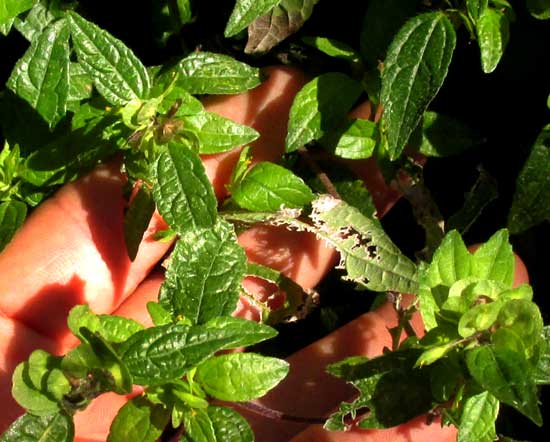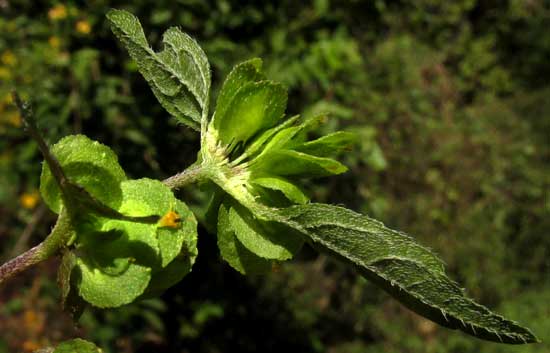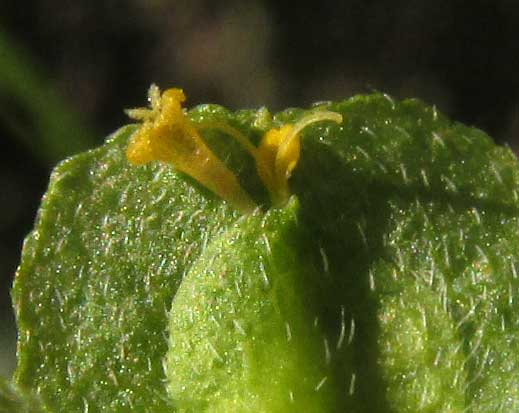Excerpts from Jim Conrad's
Naturalist Newsletter
from the December 31, 2017 Newsletter issued from Rancho Regenesis in the woods ±4kms west of Ek Balam Ruins; elevation ~40m (~130 ft), N20.876°, W88.170°; north-central Yucatán, MÉXICO
DELILIA'S SURPRISING FLOWERS
This week I was flabbergasted when I finally identified one of our most homely looking but most commonly encountered weeds, one about knee high, and especially common along the weedy border of the garden. I'd been waiting for several years to try to name this plant, until I could see the flowers. But somehow until now all I've ever see have been the herb's clusters of wafer-like fruits. below, you can see such fruit clusters a little paler than the dark green, wrinkled leaves around them:

The leaves, arising opposite one another on the stems, suggest members of the Mint and Verbena Families, but those families don't produce wafer-like fruits. The fruits suggest something in the Buckwheat Family, but the leaves are all wrong for that. This week I gave up waiting for flowers and decided to try identifying the plant just by its fruits, so I drew a sprig of the plant close and began "doing the botany" with what's shown below:

Now for the first time I noticed that some of the wafer-fruits bore tiny yellow things at their edges, one seen on a fruit in the picture's lower, left corner. With my poor vision I couldn't see what the yellow thing was, but I pushed my little camera's macro capabilities to the limit and got what's revealed below:

When that image came onto the computer screen I was stunned, for I'd never seen or heard of anything like it. Apparently the two yellow items are unisexual flowers, the larger one on the left being the male, while the one on the right is the female. At first I was flummoxed, especially because certain features here were familiar, though never seen in such a bizarre configuration.
The male flower's yellow corolla seems to have something dark within it, toward its top. In the gigantic Composite or Sunflower/Aster Family, such dark splotches often show up in the same position in disc flowers in composite-flowers' centers. They're blackish anthers connected at their edges to form a tube around the style. And the female flower with its two pale, slender, outward-bending items more or less forming a V are styles with stigmatic surfaces -- just as with ray flowers like those of the Dandelion, in the Composite Family. The styles join with the top of the bulge below the two flowers, so that bulge is where the ovary or developing fruit is, and the thin wings surrounding the bulge are destined to help the mature fruit be dispersed by wind. If you need to review the Composite Family's commonly encountered but somewhat bizarre floral structure, take a look at www.backyardnature.net/fl_comps.htm
So, yes, this is a member of the Composite/Sunflower/Aster Family, the Asteraceae, but who would have thought a species could produce such tiny ray and disk flowers, and be satisfied with just one of each?
Once all this was understood, it was easy to identify this remarkable plain-Jane species is DELILIA BIFLORA, commonly found in waste places throughout tropical America, and becoming invasive in certain other tropical countries worldwide. For such a common plant, amazingly little is known about its life cycle and uses. It's just one of those plants that people ignore, waiting for it to do something flashy, when it's already done that, by being itself!